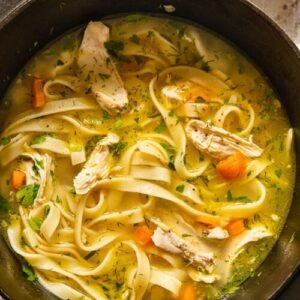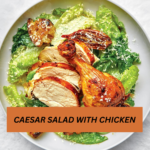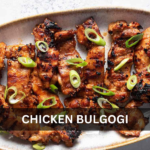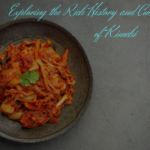Introducing Dak Kalguksu, a delicious and nutritious Korean chicken noodle soup! This classic recipe is not only comforting, but also full of healthful ingredients that will leave you feeling full and nourished. Learn how to make this delicious recipe!
WHAT IS DAK KALGUKSU
Dak Kalguksu (닭 칼국수) is a traditional Korean dish that means ‘chicken knife-cut noodle soup.’ ‘Dak’ alludes to chicken, and ‘kalguksu’ denotes knife-cut noodles.
This hearty chicken soup has thin and flat knife-cut noodles that are cooked in a rich and fragrant chicken broth, delivering both warmth and a toothsome texture.

Dak kalguksu, like samgyetang (ginseng chicken soup), is widely considered as a popular stamina booster in Korea, particularly during the summer. This concept is based on a historic Korean practice known as or, which indicates that eating hot food can help alleviate the summer heat.
Yes, you read that correctly. On blistering hot days, we frequently slurp down this steamy cup of delectable chicken noodle soup. As perspiration drips down our faces, we laugh, cheer each other on, and enjoy every last drop. Sounds hardcore, doesn’t it? No matter the season, the comfortable warmth and hearty pleasure of chicken kalguksu make it the ideal dish to eat, promising not only to warm you up but also to deliver a dinner that feels like home.
Upgraded Chicken Noodle Soup
The broth for traditional kalguksu is usually made with dried anchovies and kelp. However, chicken is the main ingredient in dak kalguksu.
And get this. Some restaurants take it a step further by including ginseng or other eastern herbal substances to enhance the dish’s stamina-boosting properties. They sometimes boil these ingredients for several hours in order to extract all of the rich flavours and nutrients.
So, you’re wondering what this enhanced chicken noodle soup is about. My initial recipe, from 2013, was all about the chicken broth. During my recent trip to Korea, however, I got the opportunity to sample some extremely refreshing chicken noodle soup. This was not your ordinary soup; it included traditional kalguksu components such as dried anchovies as well as some little neck clams. Since then, I’ve been obsessed with these flavours and felt forced to tweak my recipe to fully capture their refreshing taste.
Kalguksu’s main veggies are typically zucchini, carrots and, in some cases, potatoes. However, dak kalguksu is sometimes made with only green onions. So making the proper broth becomes really crucial!
Chicken Back (Chicken Frame)
Use chicken backs, sometimes called chicken frames! They’re inexpensive ingredients that make a delicious, cosy soup.

Chicken backs, also known as chicken frames, are the chicken carcass, which is mostly made up of bones and cartilage with some leftover meat. They’re frequently used as a base for soups and broths because of the rich flavour they may add.
Previously, I used a whole chicken to prepare this soup, but now I prefer chicken backs. They add a great flavour to the soup and keep me from having to chew through my least favourite sections of the meat, such as the chicken breast and others. It’s also much easier to handle since I don’t have to debone the chicken.
I often utilise chicken drumsticks as the meat in dak Kalguksu. They not only deliver tender meat, but they also include extra bones for a rich and tasty chicken broth.
KALGUKSU NOODLES & SUBSTITUTES
Kalguksu noodles are produced with wheat flour and water. Occasionally, some people add an egg to the concoction. The dough is then flattened out and sliced into long, thin strands with a knife. They’re recognised for their chewy texture.
These noodles are readily available at Korean grocery stores. They come in both dry and fresh varieties, with fresh noodles often located in the refrigerated or frozen department. I generally buy these noodles for convenience, but I want to publish my handmade knife-cut noodles recipe soon.
If you cannot obtain kalguksu noodles in your neighbourhood, here are some alternatives:
Udon Noodles: These Japanese noodles, manufactured from wheat flour, are similar to kalguksu. They are also available in both dried and fresh varieties. Kishimen, a flat form of udon noodles, resembles kalguksu noodles as well.
Sujebi Noodles: These Korean noodles are hand-torn rather than sliced, resulting in a rustic, uneven texture. They will work well, even if they are not long-stranded noodles. You may get the recipe here: Sujebi.
Chinese Knife-Cut Noodles (Dao Xiao Mian): These Chinese noodles, cut with a knife from a block of dough, appear to be comparable in thickness and texture to kalguksu. I haven’t tried them myself, but I’ve read they’re comparable.
Remember that, while some noodles may have similar qualities, they may not taste the same due to changes in ingredients and cooking methods.
INGREDIENTS FOR DAK KALGUKSU
SOUP BASE
- 1kg / 2.2 pounds chicken backs (chicken frames)
- 110g / 3.9 ounce onion
- 50g / 1.8 ounce green onion, white part
- 15g / 0.5 ounce garlic cloves
- 50g / 1.8 ounce dried anchovies
- 1/2 tsp whole black peppers
- 12 cup water
MAIN

- 1kg / 2.2 pounds chicken drumsticks
- 300g / 10.6 ounce little neck clams, rinsed
- 400g / 14.1 ounce kalguksu noodles (or udon noodles, *see above for more options)
- 1 tsp Korean soup soy sauce or kikkoman soy sauce
- 3/4 tsp fine sea salt, or to your taste
TOPPING (OPTIONAL)
- 30g / 1 ounce green onion, thinly sliced
SEASONING SAUCE (OPTIONAL)
- 1/4 cup soy sauce, regular (I use kikkoman brand.)
- 1 Tbsp Korean chili flakes (gochugaru)
- 1/2 Tbsp honey
- 1 Tbsp green onion, thinly sliced
- 1 tsp minced garlic
- 1 tsp sesame oil
HOW TO MAKE DAK KALGUKSU
1. Place the chicken backs in a large pot along with the other soup base ingredients and water. To make the removal process easier later on, you may want to consider using a stock bag, also known as a soup sock, which is typically made of fine mesh or cheesecloth. This bag can hold all the solid soup base ingredients. If your bag isn’t spacious enough to contain all the ingredients, prioritize enclosing the anchovies, garlic, and black pepper. These elements can be more challenging to remove later, so it’s best to ensure they are securely contained within the bag.
Bring this mixture to a boil over medium-high heat, which should take around 25 minutes. Once the water is boiling, carefully add the chicken drumsticks to the pot. Maintain the heat and let them cook for an additional 25 minutes.
2. Lower the heat to medium-low and let the broth simmer for an additional 30 minutes. Skim off any fat or scum that floats to the surface of the broth to ensure a clear soup.
3. Remove the soup base ingredients from the broth. Set the chicken drumsticks aside in a separate bowl and allow them to cool down. Once cooled, debone and skin the drumsticks, tearing the meat into bite-sized pieces.





